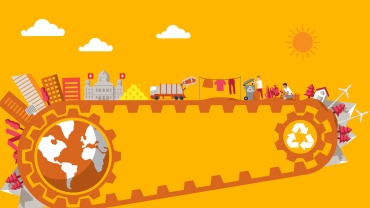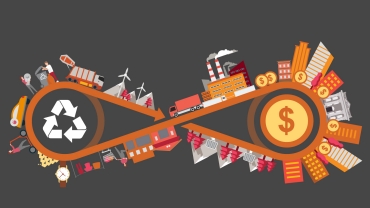
Companies can use a circular business model to maximise the value of capital and recyclable materials, boost their climate resilience and make a substantial contribution to climate goals. Dr Antonios Koumbarakis, Head Sustainability & Strategic Regulatory Initiatives at PwC Switzerland, discusses the concrete role that circular finance will assume for both stakeholders and Switzerland as a financial centre and what opportunities this will create.
Dr Koumbarakis, how exactly would you define circular finance?
Circular finance is any type of financial service or tool that involves one or more aspects of the circular economy. The aim of circular finance is to make a sustainable economy possible or to accelerate it and to advance the transition from a linear to a circular way of doing business.
Linear in what way?
At present, we manufacture something, advertise it, consume it, dispose of it and recycle it. But the majority of the raw materials do not find their way back into the economic cycle or – like plastic – can no longer be used after a few recycling cycles. As a result, resources are being wasted or are permanently lost. Today the end of the lifecycle of products or services is not necessarily the beginning of new ones.
Why do we need this paradigm shift?
Because we cannot achieve the ambitious climate and environmental goals if we uncompromisingly concentrate on the consumption of resources. Most greenhouse gas emissions are a result of linear processes.
How does circular investing fit into the framework of sustainable investing?
Sustainable investing is the umbrella term. It stems from sustainable finance and is any and all types of financial service that support the use of environmental, social and governance (ESG) criteria in investment decisions concerning sustainable benefits for clients and society. Circular investing is a sub-category of sustainable investing. It is about creating easier access to financial funding as a way to incentivise and guide investments in circular approaches and innovations. Impact investing is also a sub-category of sustainable investing that targets a clearly measurable impact. One example is cleantech funds used for hydrogen technologies in the manufacturing or recycling of products.
Why is circular finance attractive for companies in general and financial institutions in particular?
Circular finance opens up a range of opportunities. With it, companies can make a significant contribution to achieving climate goals. They also benefit from a positive image and a competitive advantage. For example, when they offer circular products at similar prices to linear products. Businesses need to take a hard look at and rethink their raw materials and semi-finished goods, seek out alternatives, gradually phase out toxic chemicals through negative screening processes, update their procurement processes and invest in innovative solutions and designs. Car seats don't need to be leather to attract customers. The key point here is to recycle materials as part of a closed loop mentality so they can be used again. Many online retailers are innovative and digital, but not always necessarily sustainable. Some clothing that is ordered online and then returned is being disposed of, for instance. This means that valuable resources are not returned to the loop.
Circular finance gives financial institutions and financial service providers the opportunity to play a key role as innovators or facilitators. They can lead the discussion, provide circular loans and promote investments in circular companies and projects. Sustainable investments have seen demand skyrocket, particularly since COVID-19.
«A strong circular economy would solve many challenges and problems posed by climate change.»
What risks need to be taken into consideration?
Switching from linear to circular involves the risk of resources becoming scarce. Financial service providers must cultivate an awareness of this risk, such as how it influences price volatility, and how to integrate this concept into their offering, thereby establishing a targeted approach.
What circular finance products are available on the market?
A vast array of vehicles – from circular bonds to loans and credit for circular investments, and venture capital for circular projects – is already available. A particular challenge for suppliers is the measurability of circularity. Here businesses need to determine which strategies should be chosen for the circular economy and which performance indicators will be used for proving sustainability in general and circularity in particular. These metrics can be combined with the new EU climate taxonomy, for instance.
Two of the instruments that have been designed for circular investments are equity funds and corporate bonds with a circular economy focus. The last year or so has seen an increase in the number of such equity funds and the volume of assets managed by them.1 Since 2019 there has also been rapid growth in the number of corporate bonds with an exclusive or partial circular economy focus.
Perhaps even more important than the instruments is the approach, which can be adopted by investors across the industry. A circular investment process can span every stage:
- Selecting the investment universe: exclusion and analysis based on the criteria of a circular economy. This should also include circular key performance indicators (KPIs) such as the hazardous waste ratio, packaging waste ratio, e-waste ratio, etc.
- Investment due diligence: integrating circular economy-related factors and data in financial analyses and investment cases.
- Portfolio construction: positioning portfolios on the basis of a circularity profile and a risk assessment.
- Monitoring: circular risk monitoring and reporting based on circularity KPIs.
- Active involvement: engaging with companies and voting on issues relating to the circular economy.
[1] According to the Ellen MacArthur Foundation, up sixfold in the first eight months of 2020.
«Circular finance provides the financial industry with the opportunity to take on a key role in the transition from a linear to a circular economy.»
How scalable are such products?
This results in a snowball effect: the more circular the economy becomes, the quicker and more extensive the development of circular products will become. The more people adjust their behaviour, the more diverse the supply will become. For companies, this means taking advantage of this effect and implementing suitable circular strategies. Scalability comes about when a company has converted all of its processes to circular ones. Scalability and circularity are intertwined and mutually reinforcing.
Why is circular finance important for Switzerland as a financial centre?
As a core industry in Switzerland, the financial sector is poised to play a decisive role in the transition to a circular economy. This will boost its image and underscore the attractiveness of Switzerland as a financial centre. Circular finance creates new business areas and jobs. Because circular approaches generate new areas of activity, job profiles and the need for new skills. Given Switzerland’s strong international ties, its role as an innovator also strengthens our country’s trade relations.
What does the regulatory timetable look like?
Circular finance remains a niche subject at the moment. But regulatory pressures are growing. In April 2021 the European Commission adopted an ambitious and comprehensive package of measures that focus on steering more money into sustainable activities. Part of this package is the EU taxonomy regulation which is aimed at fostering more investments in sustainable economic activities. This example shows that the circular economy, and with it circular finance, are gaining both in urgency and importance on the agendas of lawmakers.
What must or will happen next?
At present, this subject is not a well-known one – it needs more presence and relevance. And a generally recognised categorisation and classification of circular approaches and projects – similar to the EU climate taxonomy – is needed. Clear metrics and performance indicators aid in getting all the parties involved, such as companies, financial institutions, investors and the authorities, on the same page. What’s more, corresponding framework conditions with incentives that promote innovation and entrepreneurship and punish violations are also needed. The tax system must also be updated accordingly. And finally, we humans need to rethink our consumer behaviours. As I said, this all goes hand in hand.
#social#









